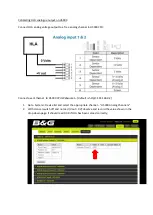
Unbolt the shaft coupling from the engine coupling.Remove the
shaft coupling from the shaft (on most installations the coupling
is held on the shaft by two set screws). Helpful hint: Removing
the shaft coupling may be difficult. The drawing below shows
the use of a spacer as a press between propeller shaft and the
transmission(fig.1)
Insert a spacer (smaller than the shaft diameter) between the
shaft and transmission.Re-tighten the coupling back onto the
transmission. You have now created a press to push the shaft
away from the coupling.
Remove your old stuffing box. (*If your boat is equipped with a
bolt on or rigid type stuffing box, please refer to heading: For
bolt-on or rigid type stuffing boxes.)
Clean shaft as thoroughly as possible with very fine sandpaper
(400 to 600 grit) and remove any sharp edges or burrs.
Slide the Friction Assembly over the shaft and connect it to your
stern tube with the provided stainless hose clamps. An insert
may be necessary for proper fit.
When mounting Friction Assembly, arrange connection hose so
that there is a minimum amount of pressure on the inner align-
ment bearing (inside the Friction Assembly). This should only
have to be done if shaft is not centralized with the stern tube in
a fairly extreme manner.
Mount connection hose crooked to relieve any major pressure
caused by misalignment. When tightening hose to Friction
Assembly with clamps, DO NOT over tighten. This may cause
Friction Assembly to grab shaft(Fig.2)
If the end of your drive shaft is not tapered, you will need to use
the included installation plug to install the Clamp/Pressure unit
over the shaft. Use liquid soap to lubricate the inner lip seals
then place the installation plug next to the lip seal inside the
unit.
Carefully slide the Assembly onto the shaft. You will need to
push the plug out the back of the Assembly using your finger as
a guide. Re-install the coupling onto the shaft and bolt the
assembly back onto the transmission.
Slide the Clamp/Pressure assembly into contact with the carbon
friction assembly and mark this “neutral” position with a magic
marker(Fig.3)
While using the “neutral” mark on the shaft, compress the
Clamp/Pressure assembly 1/4”. Keeping the assembly onto the
shaft by tightening the two bolts on the housing.
1111
110
0
5
5
6
6
77
8
8
9
9
4
4
3
3
11
2
2
R
Re
ea
ad
d A
Allll IIn
nssttrru
uccttiio
on
nss tth
ho
orro
ou
ug
gh
hlly
y b
be
effo
orre
e iin
nsstta
alllliin
ng
g
tth
he
e LLa
assd
drro
op
p G
Ge
en
n.. IIII.. B
Be
e S
Su
urre
e n
no
ott tto
o d
da
am
ma
ag
ge
e tth
he
e
iin
nn
ne
err lliip
p sse
ea
all w
wh
hiille
e u
un
np
pa
acck
kiin
ng
g a
an
nd
d h
ha
an
nd
dlliin
ng
g..
A
A
B
B
C
C
D
D
E
E
A
A
B
B
C
C
D
D
E
E
Transmission
Bolt
Spacer
Shaft Coupling
Shaft
A
A
B
B
A
A
B
B
Friction Assembly
Mounting Hose
Drawing is exaggerated for demonstration purposes
H
Hu
ullllss A
AB
BO
OV
VE
E 110
0 K
Kn
no
ottss
H
Hu
ullllss B
BE
EL
LO
OW
W 110
0 K
Kn
no
ottss
The Lasdrop Gen.II. requires water for cooling and lubrication.
The system uses a “vent line” that lets air escape from the seal
and stern tube to let water take its place. Simply route the
included hose above the water line. A valve can also be spliced
into the line and used as a safety shut off. Whenever launching
your boat, open the valve and “burp” the system.
High speed hulls must inject water into the seal. The supply to
the after-cooler, a bottom hull scoop or separate water pump are
good sources for cool clean water. It is best that the supply line
is spliced into a fresh water line using a “T” fitting. (Due to the
many different combinations of “T” sizes, this part is not includ-
ed in the kit.) The exhaust manifolds may also provide water,
but due to the excess heat of some boats and the amount of
floating debris, it is not recommended.
W
Wa
arrn
niin
ng
g!!
If engine is located below water line, DO NOT connect water coolant
line into exhaust manifold.This may flood the engine.
11
2
2
3
3
IIM
MP
PO
OR
RT
TA
AN
NT
T!!
There is, on average, a 20 minute break-in period when the
carbon face is polishing the face of the stainless steel.
During this break-in period there will be a fine black mist
being emitted during operation between the two faces.




















